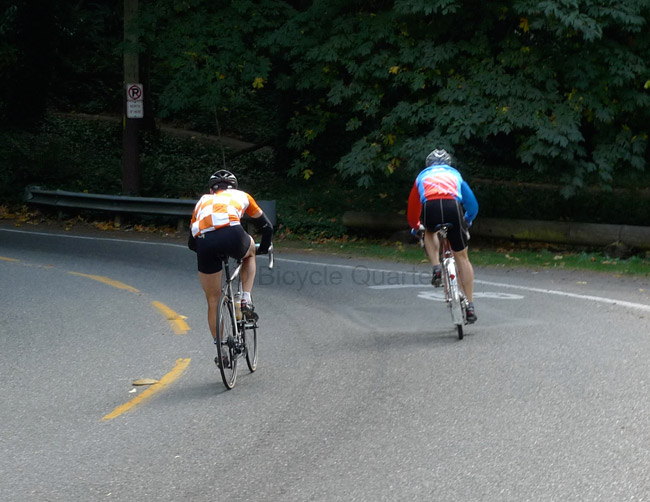Why Wider Tires Corner Better

In our last post, readers noticed the image above and asked about cornering. How am I able to lean the bike so far?
Wider bicycle tires corner better than narrower ones. This may run counter to what many cyclists believe, but it’s easy to explain. The reason is the lower pressure at which you can run wider tires without risking pinch-flats. This has two effects:
1. Wider tires run at lower pressures and thus have a larger contact patch. This simply puts more rubber on the road and increases cornering grip. While simple physical theory suggests that friction should be independent of tire width – narrower tires are pushed onto the road with more pressure – in practice, wider tires provide more interlocking surfaces between road and tire, and thus provide more grip. If you don’t believe this – after all racing bikes use relatively narrow tires – look at racecars or racing motorcycles.
2. Wider tires absorb bumps better. This keeps the wheels on the road and provides more consistent adhesion. A narrow, high-pressure tire skips over the surface, which limits its grip. Even the smoothest asphalt is surprisingly rough. That is why race cars and racing motorbikes have suspension, and why they run their tires at 35-40 psi. If you inflate your tires to 90 psi or more, you are giving up a lot of cornering adhesion. (For the same reason, tires with stiff sidewalls don’t corner as well, because they don’t absorb the vibrations and bumps like tires with supple sidewalls.)

So much for the theory – how does it translate into the real world? A few years ago, we tested two titanium racing bikes against a 650B randonneur bike. We raced two bikes side-by-side up a steep hill (above), then turned around and rode back down the twisty descent.
I have talked about the uphill part of this test elsewhere, but the downhill part was equally surprising: In the corners, the racing bike with its 25 mm tires could not keep up with the randonneur bike on its 42 mm tires. The riders changed bikes, but it was always the randonneur bike that went down the hill faster. There were two corners, one extra-smooth with new pavement, the other bumpy. The wider tires were better in both corners. Not surprisingly, the advantage was magnified in the bumpy corner. And since the randonneur bike exited the corner faster, it also went faster on the straight that followed.
How did it feel riding the racing bike? I was one of the riders, and I consider myself a good descender, so I wasn’t happy when second tester Mark distanced me while he was on the randonneur bike. While I was riding the racing bike, I had to try hard to keep up. The first, smooth corner felt a bit unsettled, but then I really frightened myself in the second corner. I picked a good line that avoided the bumps, but my front wheel started skipping across the surface. I had to open the radius of my corner and went about a foot into the oncoming lane at the corner exit. In the same spot, the randonneur bike’s wide front tire simply keyed into the surface and rounded the corner without drama. (Both bikes were equipped with Compass tires, so the tread compound was the same.)

Of course, you can’t just slap wider tires onto any bike and expect it to corner like a machine custom-designed to optimize the handling. Here are some of the issues:
- A wider tire’s larger contact patch stabilizes the bike. (This is called pneumatic trail.) If your bike’s geometry isn’t designed for wide tires, then your bike can feel sluggish in its response to steering inputs when you increase the tire size.
Solution: Decrease the geometric trail to account for the pneumatic trail of the tires. - Wider tires tend to be a bit heavier, and thus have more rotational inertia. This makes the bike more reluctant to turn into a corner, or to change its line in mid-corner.
Solution: Reduce the wheel size as the tire gets wider, to keep the rotational inertia within the range that gives the best handling. - Wide tires run at low pressures, but too low pressures can allow the tire sidewall to collapse under the cornering forces, which is not good at all.
Solution: Make sure your tires are inflated enough to prevent sidewall collapse even under hard cornering. Especially supple tires don’t have much sidewall stiffness, and need a little more air pressure to hold them up.
Beyond that, technique can help. On bikes that are too stable because their tires are wider than is optimal, you may need to actively countersteer (that is, push the handlebars to the outside of the curve) to get the bike to lean. On optimized bikes, you do that, too, but you never notice it because the amount of countersteer is totally intuitive.
Overall, there is little doubt that wider tires corner better, all things being equal.
Further reading:
- Balancing and Cornering on a Bicycle: Bicycle Quarterly 34 (Winter 2010)
- Countersteering: Bicycle Quarterly 50 (Winter 2014)
- Tire Tread — What Does it Do? Bicycle Quarterly 43 (Spring 2013)
- Wheel Size and Bicycle Handling: Bicycle Quarterly 31 (Spring 2010)
- Gyroscopic Forces and Optimum Wheel Sizes:Bicycle Quarterly 31 (Spring 2010)


